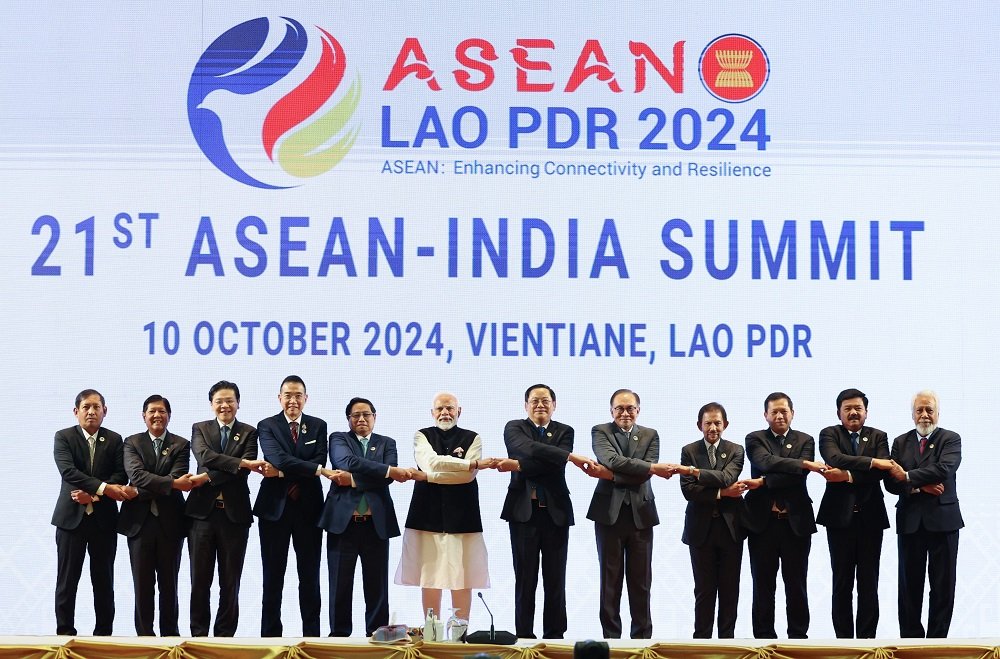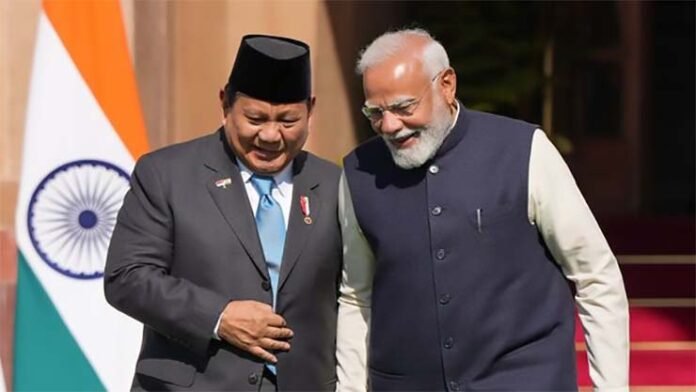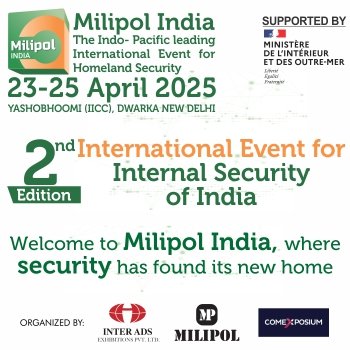Last week, before Indonesian President Prabowo Subianto undertook a four-day visit to India to be the Chief Guest at the country’s 76th Republic Day function, New Delhi had thrown a red-carpet welcome for Tharman Shanmugaratnam, President of Singapore during his maiden visit to India.
Both visits took place in January and they added to India’s impetus towards a stronger and effective engagement with Southeast Asian nations, which earlier saw Thailand’s Foreign Minister making an official trip to New Delhi last year in July, followed by Vietnamese Prime Minister Pham Minh Chinh’s visit at the end of July 2024 and Malaysian Prime Minister Anwar Ibrahim’s trip in August 2024.
Prime Minister Narendra Modi also embarked on a state visit to Brunei and Singapore on September 3-4, adding to India’s ongoing move to deepen its reach among China’s close neighbours, which are worried about Beijing’s rising military activities in the region.
China’s Growing Wariness
While Singapore, a maritime nation which is located strategically at the entrance to the Strait of Malacca, is concerned about uncertainty engulfing the region, especially over the South China Sea where escalation of tension has a chance of impacting the stability of Southeast Asia.
The city-state wants to be closely aligned militarily with India, even as it is pushing the threshold of bilateral engagement between the two countries through collaboration on critical technologies. Unlike Singapore, however, Indonesia wants to have partnership with India in various areas, including defence manufacturing.
However, what makes China feel nervous about this is that Indonesia together with the Philippines, Vietnam and Malaysia has gone far in forging closer relationships with India in the defence area and wants to purchase strategic weapons of far significant deterrent effect.
This has taken place when China’s military technology, generally seen as not meeting the highest global standards like those from the US, Russian, French or other European countries, has failed to find any favourable response recently from Southeast Asia nations, even from Myanmar, which is the biggest operator of Chinese arms.
According to the Singapore-based Lee Kuan Yew School of Public Policy, from 2010 to 2022, Chinese arms export to Southeast Asian countries only increased slightly, around 0.14 to 2.3 %, and repeat orders have been few. It is amid this scenario, that China’s Southeast Asian neighbours’ move to buy weapons from India, has helped New Delhi in strengthening its strategic ties to the region, which is what rattles Beijing.
What makes China feel nervous about this is that Indonesia together with the Philippines, Vietnam and Malaysia has gone far in forging closer relationships with India in the defence area and wants to purchase strategic weapons of far significant deterrent effect
India-Indonesia Strategic Cooperation
The Indonesian Foreign Ministry described President Subianto’s visit to India as “an affirmation of the deepening and widening strategic cooperation between the two countries, especially in the economic, security and maritime sectors.”
On January 27, Chief of Staff of the Indonesian Navy Admiral Muhammad Ali visited BrahMos Aerospace Private Limited in New Delhi, signalling Jakarta’s interest in purchasing weapons from India. It wants to follow the Philippines in acquiring supersonic BrahMos missiles. It wants to procure a shore-based version of BrahMos missile, which can be mounted on warships as well. Indonesia is concerned about growing military assertiveness of China in the region.
In October last year, a day after Chinese President Xi Jinping sent his special representative and Vice President Han Zheng to Jakarta to attend inauguration of President Prabowo Subianto, tension flared up between the two countries after a Chinese Coast Guard vessel twice tried to disrupt a seismic data survey being conducted by an Indonesian energy company in the country’s exclusive economic zone in the North Nauna Sea.
Like Malaysia, the Philippines, Vietnam, Brunei and Taiwan, Indonesia does not have any territorial dispute with China over the South China Sea. Despite this, Chinese ships have regularly entered its exclusive economic zone in the North Natuna Sea, as Beijing claims it falls within its so-called U-shaped nine-dash line that includes 90% of the South China Sea.
The expansionist design of China has created a trust deficit between Jakarta and Beijing. To counter China’s belligerence, Indonesian President Subianto appears all set to prioritise enhancing Indonesia’s defence capabilities and modernising the military to safeguard its national interests.
Interestingly, Indonesia, which has historically sourced missiles from Europe, has avoided military deals with China and Russia. It has purchased weapons from Sweden, Belgium, Italy, the US, and South Korea. In coming days, India will expectedly join the list of countries which currently supply weapons to Indonesia, indicating the Southeast Asian nation’s preference for defence partners which do not add complexity in terms of security, maintenance and, also training.
India and Indonesia are cooperating with each other in all facets of military engagements. From being partners in multilateral naval exercise Komodo and Milan to bilateral army exercise Garuda Shakti, naval exercise Samudra Shakti and Indian Coast Guard-Bakamla Cooperation – the two countries work closely on as many as 13-defence related activities.
Last year in November, military personnel of the two countries took part in the 9th edition of GARUDA SHAKTI 24, while the 43rd edition of India-Indonesia Coordinated Patrol (IND-INDO CORPAT) between Indian Navy and Indonesian Navy was held in December 2024 at Sabang in Aceh.
Chinese arms export to Southeast Asian countries only increased slightly, around 0.14 to 2.3 %, and repeat orders have been few. It is amid this scenario, that China’s Southeast Asian neighbours’ move to buy weapons from India
India-Vietnam Defence Cooperation
Vietnam too shares prickly relations with China over the South China Sea. Over the years, Hanoi has consistently protested China’s actions in the South China Sea, especially the building of artificial islands and their heavy militarisation in disputed areas.
In May 2014, a Chinese vessel rammed and sank a Vietnamese fishing boat in the disputed South China Sea. The same tactics of intimidation were adopted by China in June 2020 when a Chinese ship rammed a Vietnamese fishing boat operating in the Paracel Islands of the South China Sea. Such intimidatory approaches forced Vietnam to cancel $1 billion worth of oil projects in the South China Sea.

It is this volatile relationship with China coupled with territorial disputes in the South China Sea, that has compelled Vietnam to modernise and diversify its defence purchases. Under its modernisation move for its armed forces, it is about to spend $10.2 billion by 2029, with a compounded annual growth rate (CAGR) of 5.6%, according to GlobalData, a data and analytics company.
Vietnam’s plan to ink a $700 million worth deal with India for supersonic BrahMos cruise missile falls within Hanoi’s modernisation initiative. During Pham Minh Chinh’s visit to India from July 30 to August 1, first by a Vietnamese Prime Minister after the two countries established a strategic partnership in 2016, New Delhi extended two Lines of Credit (LoC) amounting to $300 million to Hanoi to bolster its maritime security.
India and Vietnam enjoy strong defence relations. India has aided Vietnam in strengthening its naval capabilities, including offering training, equipment, and expertise. The Indian Navy has also engaged in joint maritime exercises with the Vietnamese Navy, enhancing interoperability
India and Vietnam enjoy strong defence relations. India has aided Vietnam in strengthening its naval capabilities, including offering training, equipment, and expertise. The Indian Navy has also engaged in joint maritime exercises with the Vietnamese Navy, enhancing interoperability. In May 2024, India sent INS Kiltan, an indigenous ASW corvette to participate in the maritime partnership exercise in the Vietnamese waters.
In November 2024, armies of India and Vietnam conducted the 5th edition of bilateral exercise VINBAX 2024 at Ambala and Chandimandir. These bilateral exercises along with regular defence dialogues, supply of defence technology and training have contributed to enhancing mutual understanding and alignment of defence strategies between the two countries.
India-Philippines Defence Partnership
As part of its push to secure its maritime interests in the South China Sea, the Philippines signed a $375 million deal with India in 2022. Manila is planning to acquire two more batteries of the shore-based supersonic anti-ship missiles by 2026 after the delivery of all three-battery of BrahMos Missile system.
Last year, Philippines envoy to India, Josel F Ignacio termed the BrahMos cruise missiles as a “game changer” while maintaining that India is a major source for the modernisation of the Philippines armed forces.
Under its ‘Act East’ policy, India has imparted thrust to its people-to-people, cultural and economic ties with countries of Southeast Asia; its growing role in regional security and adoption of various defence initiatives in the region have complicated China’s vision of an Asia under its economic and military influence
“China Threat” has been cited as the key reason for the Philippines’ decision to go for BrahMos missile which has a range between 300 and 500 km. Travelling at a speed of Mach 2.8 to Match 3 (approximately 3,400 to 3,700 km/h or 2,100 to 2,300 mph), BrahMos, which carries a warhead weighing between 200kg and 300kg, has a ripple effect on China.
Addressing a media briefing, Chinese Defence Ministry spokesperson Wu Qian last year in April said, “China always believes that defence and security cooperation between countries should not harm the interest of any third party and should not harm regional peace and stability.” For China, however, the growing defence partnership between India and the Philippines in line with New Delhi’s interest for a peaceful and stable Indo-Pacific region, has been a direct challenge to its dominance in Southeast Asia.
In December 2023, India sent its naval ship INS Kadmatt to Manila when tension flared up between the Philippines and China in the South China Sea. In May 2024, INS Delhi, Shakti and Kiltan visited Manila as part of operational deployment of the Indian Navy’s Eastern Fleet to the South China Sea. It demonstrated India’s commitment to further deepen the partnership with the Philippines.
Overall, under its ‘Act East’ policy, India has imparted thrust to its people-to-people, cultural and economic ties with countries of Southeast Asia; its growing role in regional security and adoption of various defence initiatives in the region have complicated China’s vision of an Asia under its economic and military influence. But India is committed to strengthening its engagement with Southeast Asia. It is happening as China feels surrounded by a network of alliances and partnerships aimed at curbing its influence in the Indo-Pacific.
–The writer is a senior journalist with wide experience in covering international affairs. The views expressed are of the writer and do not necessarily reflect the views of Raksha Anirveda

















